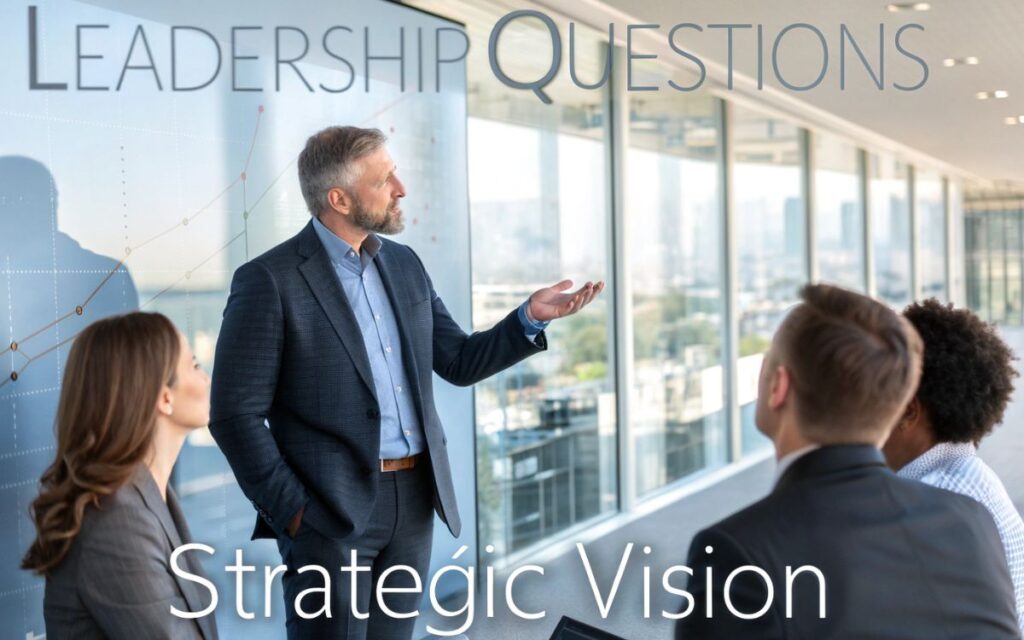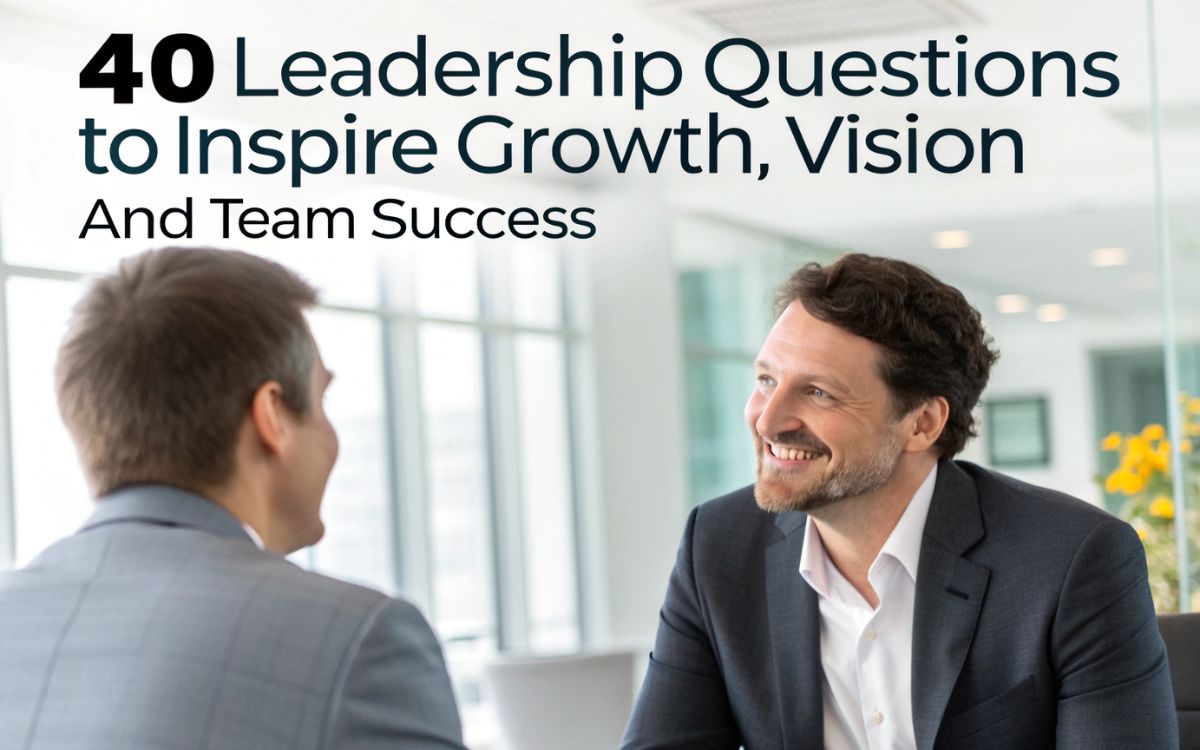Great leaders don’t claim to have all the answers—they ask the right questions. These 40 leadership questions will help you assess your management style, strengthen team dynamics, and drive organizational success.
Whether you’re a seasoned executive or newly promoted manager, this comprehensive guide provides the reflective prompts you need to elevate your leadership impact..
Self-Assessment Leadership Questions
Self-awareness drives effective leadership by revealing your values, actions, and true impact through honest self-reflection.
1. What core values guide my decision-making process?
Answer: My decisions reflect integrity, accountability, and people-first principles that remain consistent regardless of external pressure. I reference these values explicitly when facing dilemmas, ensuring alignment between stated beliefs and actual behaviors. Regular values audits help me identify when convenience tempts me to compromise what matters most.
Why this question matters: Leaders without defined values make inconsistent decisions that erode team trust and create cultural confusion.
2. Am I leading from a place of authenticity or performing a role?
Answer: Authentic leadership means bringing my whole self to work, including acknowledging limitations and admitting mistakes without defensive posturing. I evaluate whether my leadership persona matches my private character, looking for performance gaps that signal inauthenticity. Team members detect fabricated leadership instantly, so congruence between who I am and how I lead is non-negotiable.
Why this question matters: The authenticity gap destroys credibility faster than any single mistake ever could.
3. Which leadership moments made me proudest this quarter?
Answer: Celebrating wins—especially small victories—reinforces positive leadership patterns and builds momentum for continued growth. I document specific instances where my actions aligned with my leadership aspirations, noting circumstances and decisions that created those outcomes. This practice trains my brain to recognize and repeat behaviors that generate the results I want.
Why this question matters: What you focus on expands, and tracking proud moments helps you replicate success systematically.
4. Where do I consistently compromise my leadership principles?
Answer: Integrity gaps emerge when time pressure, political convenience, or fear override my stated values, revealing areas requiring immediate attention. I identify recurring situations where I rationalize shortcuts, recognizing these patterns as symptoms of deeper misalignment. Closing these gaps requires courage, clear boundaries, and sometimes difficult conversations about realistic expectations.
Why this question matters: Small compromises accumulate into character erosion that eventually undermines your entire leadership foundation.
5. How would my team describe my leadership style in three words?
Answer: Perception is reality in leadership, and soliciting honest feedback reveals the gap between intended impact and actual experience. I create psychological safety that permits candid responses, understanding that defensive reactions to criticism guarantee future silence. Anonymous surveys, trusted intermediaries, or direct conversations can surface truth if I genuinely want to hear it.
Why this question matters: Self-perception rarely matches how others experience your leadership, and that disconnect creates preventable problems.
6. What leadership blind spots am I ignoring?
Answer: Blind spots exist precisely because I can’t see them alone, requiring external perspectives from mentors, peers, or 360-degree assessments. Common blind spots include communication style impacts, unintended favoritism, or emotional reactivity that others notice but I don’t. Addressing blind spots demands humility and the willingness to accept uncomfortable truths about my leadership shortcomings.
Why this question matters: Unacknowledged weaknesses become your Achilles heel, exploited by circumstance when you least expect it.
7. Do I invest more energy in tasks or people?
Answer: Task-obsessed leaders achieve short-term wins while sacrificing long-term team development and sustainable performance. I audit my calendar and energy allocation, assessing whether people development receives equivalent attention to project delivery. Recalibration might mean delegating more tasks to create space for coaching conversations and relationship building.
Why this question matters: Tasks change constantly, but investing in people creates capability that multiplies your leadership impact exponentially.
8. Am I building leaders or creating followers?
Answer: Empowering leaders means transferring knowledge, delegating meaningful authority, and celebrating when team members outgrow their current roles. I evaluate whether my actions develop independence or dependency, recognizing that followers need me while leaders need opportunity. Succession planning isn’t about replacement—it’s about multiplying leadership capacity throughout the organization.
Why this question matters: Creating followers might stroke your ego, but building leaders ensures organizational longevity beyond your tenure.
9. What fears prevent me from taking bold leadership actions?
Answer: Fear of failure, criticism, or losing control paralyzes leaders into playing safe, choosing preservation over innovation. I name specific anxieties—public embarrassment, career setback, team disappointment—rather than masking them with rational justifications. Courage isn’t the absence of fear; it’s taking action despite fear after carefully assessing genuine risks.
Why this question matters: Unnamed fears control you unconsciously, but identified fears become obstacles you can strategically overcome.
10. How have I grown as a leader in the past year?
Answer: Documenting leadership evolution prevents the illusion of growth while maintaining stagnant patterns and outdated approaches. I compare current capabilities to previous limitations, noting specific skills acquired, mindsets shifted, and behaviors modified. Growth tracking maintains momentum and provides evidence that continuous development is possible regardless of experience level.
Why this question matters: Without intentional reflection, years of experience become one year repeated multiple times rather than cumulative wisdom.
Team Development Leadership Questions

Your team’s performance reflects your leadership effectiveness. These questions about leadership and team building help you diagnose dynamics, unlock potential, and create environments where people thrive.
11. Does each team member know how their work contributes to our mission?
Answer: Purpose-driven employees demonstrate 64% higher engagement and produce significantly better outcomes than those viewing work as disconnected tasks. I regularly connect individual contributions to organizational impact through storytelling, progress updates, and celebrating milestone achievements. When people understand the “why” behind their work, discretionary effort follows naturally without micromanagement.
Why this question matters: Mission disconnect transforms talented people into clock-watchers who do minimum required work without passion.
12. Who on my team isn’t reaching their potential, and why?
Answer: Untapped potential represents my failure to remove barriers, provide resources, or create conditions where capability flourishes. I identify individuals performing below their capacity, investigating whether obstacles stem from unclear expectations, skill gaps, or environmental constraints. Addressing these barriers is my responsibility—blaming the individual for underperformance ignores leadership’s primary function.
Why this question matters: Unrealized potential wastes human capability and signals leadership blind spots preventing team optimization.
13. What conversations am I avoiding with my team?
Answer: Difficult dialogues postponed become crises later, compounding damage while eroding credibility and trust simultaneously. I list uncomfortable topics I’m dodging—performance concerns, strategic disagreements, interpersonal conflicts—acknowledging that avoidance serves my comfort, not team health. Psychological safety requires leaders who address issues directly with respect and clarity.
Why this question matters: Avoiding hard conversations is cowardice disguised as kindness, ultimately hurting both individuals and team performance.
14. How diverse are the perspectives in my team’s decision-making?
Answer: Cognitive diversity prevents groupthink and generates innovative solutions that homogeneous teams miss entirely. I assess whether decision-making includes varied backgrounds, experiences, and thinking styles, or whether we’ve created an echo chamber. True inclusion means actively soliciting dissenting opinions and creating space where minority perspectives influence outcomes.
Why this question matters: Teams that think alike produce predictable, mediocre solutions while missing breakthrough opportunities hiding in alternative viewpoints.
15. Am I micromanaging or empowering autonomy?
Answer: Micromanagement signals trust deficits and capability underestimation, creating dependency that stifles growth and initiative. I evaluate whether my involvement adds genuine value or merely satisfies my control needs and anxiety. Empowerment requires clear expectations, available resources, and tolerance for methods differing from how I’d approach tasks.
Why this question matters: Micromanagement exhausts you while infantilizing capable adults who eventually leave for environments respecting their competence.
16. What does my team need from me that they’re not getting?
Answer: Unspoken needs fester into resentment and disengagement when leaders assume rather than ask what support requires. I create regular forums—skip-level meetings, anonymous surveys, open office hours—where team members can articulate needs honestly. Sometimes they need clearer direction, sometimes resources, sometimes just less interference.
Why this question matters: Mind-reading isn’t a leadership competency; creating channels for honest need expression is.
17. How do I respond when team members fail?
Answer: Failure response reveals leadership character more than success celebration ever could. I treat failures as learning laboratories, conducting blameless postmortems that extract lessons without destroying confidence or courage. Growth-oriented feedback focuses on future improvement rather than past mistakes, maintaining psychological safety essential for innovation.
Why this question matters: Teams led by leaders who punish failure stop taking risks, innovating, or stretching beyond guaranteed success.
18. Are my high performers being challenged or complacent?
Answer: Top talent requires stretch assignments, growth opportunities, and intellectual stimulation to remain engaged and committed. I assess whether star players face challenges matching their expanding capabilities or coast on past mastery. Retention strategy for high performers isn’t compensation alone—it’s continuous development preventing stagnation.
Why this question matters: Complacent high performers become bored flight risks who leave for organizations offering growth opportunities you failed to provide.
19. What recognition have I offered this week?
Answer: Appreciation frequency matters more than grand gestures, with specific, timely recognition reinforcing desired behaviors effectively. I audit recent recognition patterns, ensuring acknowledgment reaches all contributors rather than favored individuals. Genuine gratitude costs nothing yet generates disproportionate loyalty and motivation when delivered authentically.
Why this question matters: People leave managers who make them feel invisible regardless of compensation or title.
20. Do team members feel psychologically safe disagreeing with me?
Answer: Psychological safety—the belief you can speak up without punishment—predicts team performance better than individual talent. I evaluate whether people challenge my ideas, voice concerns, or raise problems openly, or whether they’ve learned silence protects careers. Dissent-welcoming behaviors include thanking critics, acknowledging when I’m wrong, and rewarding constructive pushback.
Why this question matters: Without psychological safety, you lead a team of yes-people whose silence ensures you’ll eventually make catastrophic unchallenged mistakes.
Strategic Vision Leadership Questions

Strategy distinguishes leaders from managers. These strategic leadership questions ensure you’re driving toward meaningful destinations rather than efficiently navigating nowhere.
21. Can I articulate our team’s purpose in one sentence?
Answer: Clarity tests reveal whether strategy exists or whether vague aspirations masquerade as direction. I distill our mission into one memorable sentence that anyone could recall and explain to others. If I can’t express purpose concisely, my team certainly can’t operate from shared understanding.
Why this question matters: Clarity precedes commitment; ambiguous purpose generates diffused effort producing mediocre results.
22. What would I do differently if budget weren’t a constraint?
Answer: Removing financial constraints from thought experiments unlocks creative problem-solving often applicable within actual resource limits. I imagine unlimited funding scenarios, identifying which initiatives I’d pursue immediately, revealing true priorities versus convenient excuses. Sometimes “we can’t afford it” masks “I haven’t figured out how to prioritize it.”
Why this question matters: Artificial constraints become mental prisons preventing innovative resource reallocation and creative solution generation.
23. Are we solving the right problems?
Answer: Efficiency at solving the wrong problems wastes more resources than inefficiency at solving correct ones. I validate whether current efforts address root causes or merely symptoms, using frameworks like Five Whys to ensure proper problem identification. Strategic thinking requires periodically questioning not just how we solve problems but which problems deserve solving.
Why this question matters: Organizations full of busy people solving irrelevant problems eventually become obsolete regardless of execution quality.
24. What industry trends am I dismissing that could disrupt us?
Answer: Complacency blinds successful organizations to threats until disruption becomes unavoidable crisis rather than manageable challenge. I list emerging trends I’ve minimized, honestly assessing whether dismissal stems from evidence or comfort-seeking denial. Horizon scanning requires humility to acknowledge that today’s advantages become tomorrow’s liabilities without adaptation.
Why this question matters: Every disrupted industry had leaders who saw change coming but rationalized why “we’re different” until they weren’t.
25. How does my leadership today serve our three-year goals?
Answer: Daily decisions disconnected from long-term strategy accumulate into destination arrival nowhere near intended coordinates. I evaluate whether today’s actions build capability, relationships, and positioning necessary for future success. Short-term urgency constantly threatens long-term importance unless I deliberately protect strategic priorities from daily fires.
Why this question matters: Without explicit connection between daily leadership and long-term vision, you’ll spend years climbing ladders against wrong walls.
26. What would our biggest competitor say about us?
Answer: External perspective adoption reveals competitive positioning blind spots your team might miss from internal viewpoint. I imagine sitting in competitor strategy meetings, articulating how they view our strengths, weaknesses, and vulnerabilities. This exercise often surfaces uncomfortable truths about market perception versus self-perception.
Why this question matters: Competitors see you more objectively than you see yourself, and ignoring their perspective guarantees strategic surprises.
27. Which initiatives should we stop to focus on what matters?
Answer: Strategic subtraction requires more courage than addition, eliminating comfortable activities consuming resources without proportional returns. I identify legacy projects continuing from momentum rather than merit, creating space for higher-value work. Success requires not just doing right things but stopping wrong things despite sunk costs and emotional attachments.
Why this question matters: Organizations rarely fail from doing too little; they collapse under weight of doing too much mediocrely.
28. Am I communicating vision consistently across all channels?
Answer: Message repetition across multiple forums ensures penetration through organizational noise and competing priorities. I audit whether town halls, emails, one-on-ones, and casual conversations reinforce consistent themes or scatter attention across disconnected messages. Leaders underestimate repetition required for message retention by approximately 700%.
Why this question matters: Saying something once means approximately nobody heard it; consistent multi-channel communication drives understanding and alignment.
29. What assumptions are we making that might be wrong?
Answer: Unchallenged assumptions become organizational doctrine, calcifying into constraints that prevent adaptation when circumstances shift. I list beliefs we treat as facts—about customers, competitors, capabilities—subjecting them to evidence testing. Hypothesis mindset treats assumptions as temporary theories requiring validation rather than permanent truths.
Why this question matters: Wrong assumptions compound over time, eventually constructing entire strategies on foundations that never existed.
30. How are we measuring what truly matters?
Answer: Vanity metrics create false confidence while obscuring genuine performance indicators revealing actual progress toward goals. I distinguish between measures that feel good and metrics that drive decisions, eliminating dashboard clutter. What gets measured gets managed, so measurement selection directly determines organizational focus and behavior.
Why this question matters: Measuring the wrong things optimizes for irrelevant outcomes while the business imperceptibly declines on dimensions you ignored.
Communication and Influence Leadership Questions

Leadership without communication is merely position without power. These leadership communication questions sharpen your ability to connect, persuade, and inspire.
31. Do I listen more than I speak in meetings?
Answer: Listening ratio correlates strongly with leadership effectiveness, with best leaders speaking approximately 20-30% of meeting time. I track my airtime, assessing whether I’m dominating conversations or creating space for others’ contributions. Active listening—demonstrated through clarifying questions and synthesizing others’ points—signals respect and generates better decisions.
Why this question matters: Leaders who dominate conversations miss crucial information while signaling that others’ perspectives don’t matter.
32. How transparent am I about challenges we’re facing?
Answer: Appropriate vulnerability builds trust and credibility, while excessive disclosure creates anxiety without empowering action. I evaluate whether I share difficulties honestly while framing them within broader context and clear action plans. Teams handle truth better than uncertainty, but transparency requires balancing candor with confidence-building.
Why this question matters: Hidden challenges discovered through rumors destroy trust faster than honestly acknowledged difficulties ever could.
33. What stories am I telling that shape our culture?
Answer: Narrative leadership leverages storytelling to transmit values, celebrate exemplars, and reinforce desired behaviors throughout organization. I inventory recent stories I’ve shared—about customer wins, team overcoming obstacles, individuals embodying values—recognizing their culture-shaping power. Stories bypass rational defenses, embedding lessons memorably in ways data and directives cannot.
Why this question matters: Culture forms from stories told repeatedly, not from values posters hanging ignored on walls.
34. Am I asking questions or giving directives?
Answer: Question-based leadership develops thinking capability while directive-based management creates order-following dependency. I assess my default communication style, recognizing that questions engage brains while commands engage hands. Coaching conversations that ask “What do you think?” generate ownership that telling “Do this” never achieves.
Why this question matters: Questions build leaders; directives build followers who become helpless when you’re unavailable.
35. How do I handle disagreement in public forums?
Answer: Conflict navigation in visible settings models organizational norms for handling disagreement throughout the team. I evaluate whether I welcome dissent respectfully, become defensive, or shut down opposition, understanding everyone watches these moments. Respectful debate that values ideas over egos creates cultures where best thinking wins regardless of hierarchy.
Why this question matters: Public conflict handling teaches more about acceptable behavior than any workshop or policy ever could.
Personal Growth Leadership Questions

Leaders who stop growing stop leading effectively. These leadership development questions ensure you’re continuously sharpening skills and expanding capabilities.
36. What leadership skill am I actively developing right now?
Answer: Deliberate practice requires targeted skill development with feedback and repetition rather than vague improvement hopes. I identify specific competencies I’m strengthening—active listening, strategic thinking, difficult conversations—with measurable progress indicators. Lifelong learning isn’t accidental; it’s systematic cultivation of capabilities relevant to evolving challenges.
Why this question matters: Without intentional skill development, leadership capability plateaus while organizational demands continuously escalate.
37. Who challenges my thinking, and do I seek them out?
Answer: Advisory relationships with people who disagree constructively prevent echo chamber thinking and cognitive complacency. I identify individuals who push my assumptions, offer alternative perspectives, and tell me what I need hearing. Seeking out disagreement requires ego security and genuine curiosity about better approaches than current methods.
Why this question matters: Leaders surrounded by yes-people make progressively worse decisions without realizing declining judgment quality.
38. What energizes me versus drains me in my leadership role?
Answer: Energy management matters more than time management for sustainable leadership performance and personal well-being. I map activities by energy impact, identifying draining responsibilities requiring protection through boundaries, delegation, or reframing. Playing to strengths while managing around weaknesses creates sustainable leadership rather than exhausting yourself through poorly-fitted responsibilities.
Why this question matters: Burned-out leaders make poor decisions, model unhealthy behaviors, and eventually exit either voluntarily or involuntarily.
39. How do I recover from leadership setbacks?
Answer: Resilience mechanisms—whether journaling, trusted advisors, physical activity, or reflection time—enable rapid recovery from inevitable failures. I examine my bounce-back process, assessing whether I learn from setbacks or spiral into shame and self-criticism. Failure processing determines whether mistakes become learning laboratories or career-limiting wounds.
Why this question matters: Leadership guarantees failure; how you handle it determines whether you grow or quit.
40. What legacy am I creating through my leadership?
Answer: Impact consciousness means considering how current actions create lasting effects beyond tenure or immediate results. I envision what people will say about my leadership after I’ve moved on, whether I’ve developed successors and strengthened organizational capability. Legacy isn’t about monuments; it’s about people, culture, and capabilities persisting after your departure.
Why this question matters: Leaders forgotten immediately after leaving had position without impact, authority without influence.
Conclusion
Leadership excellence emerges from consistent self-examination, honest assessment, and courageous action based on reflection insights. These 40 leadership questions provide your framework for continuous improvement across every dimension of effective management. Start today—pick one question, answer honestly, and take one concrete action based on what you discover.
FAQ’s
Q: What are good leadership questions to ask in interviews?
Ask questions that reveal real decision-making and conflict-handling skills.
Q: Can these leadership questions work for new managers?
Yes, start simple to build reflection habits and grow from there.
More Posts
158+ Comebacks to “You Are So Funny” with Witty and Clever Responses
145+ Heartfelt Ways to Respond to Get Well Soon Messages with Gratitude
148+Perfect Replies When Someone Asks “Why Are You So Cute?” With Love

At Romancesaba.com, we’re Soulmates with Romance. Our admin Shares Heartfelt Ideas on Love, Flirting Tips, and Dreamy Destinations to spark Deep Connections and Unforgettable Romantic Journeys.






